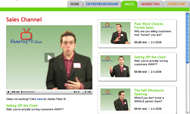 1. Acknowledge the common fears of your listeners. Help them realize they’re not the only ones who are scared. Then, share that YOU were scared, and how you overcame it.
1. Acknowledge the common fears of your listeners. Help them realize they’re not the only ones who are scared. Then, share that YOU were scared, and how you overcame it.
2. Give it away. As a Thought Leader, projecting a sense of scarcity isn’t attractive. Just dump every relevant fact. Fear not that your value will be reduced.
3. Be as detailed as possible. The more details you provide, the easier it is for your callers to execute.
4. Attitude. Be confident without swagger.
5. Acid test. Before you deliver ANY content, ask this simple question: Does this give the impression of VALUE or VANITY in the eyes of my listeners?
6. Be funny early and often. Funny is relaxing. Funny makes you appear smarter. Funny makes you more listenable. Funny wins approval. Funny builds trust. Funny captivates attention. Funny lubricates the informational digestive system. Funny makes learning easier. Funny is engaging. In short: Just be funny and you’re halfway there.
7. Breath is fuel. Establish an inner foundation to fuel your phone calls with the passion and energy you need to become more listenable. Do a few breathing exercises before the call. Also, post a sticky note that reads, “BREATHE” by your phone. That will remind you to pause and breath throughout the call. This creates the space needed to punctuate your message with appropriate silences.
8. Constantly throw in unrelated facts. It proves you’re well read and makes the call more interesting.
9. Ahhh. Demonstrate that you’re relaxed immediately. Callers will do the same.
10. Structure. Deliver a flow of inspiring content in an engaging and witty way.
11. Disturb and offend people. Those who are comfortable do not act.
12. Don’t share things to show how smart you are. Offer insight with the intent to help the attendee understand something.
13. No vomit.Don’t spew a steady stream self-glorifying wisdom; instead, challenge people by leaving them with any Meaningful Concrete Immediacy, (MCI).
14. Also. Don’t give people the ability to remain mediocre.
15. Energy. Don’t just have fun, SOUND like you are having fun.
17. Contact. Enable the ability to email, tweet or connect with listeners during the program.
18. Goal. Get people thinking about THEMSELVES in a different way.
19. Know. Have a clear understanding of who your audience is and what their pain is.
20. The art is hiding the art. If you sound rehearsed, people will start checking email while they’re listening to you. So, the best way to sound like you’re not rehearsed is to spend hours and hours rehearsing.
21. Openness. Make it clear that you welcome communication: Questions, emails, messages, etc.
22. Make your content actionable. Your listeners need to think, “I believe this! I can do this! I want to try this!” after they’ve been exposed to your ideas. Otherwise, your material, ideas and presentations are nothing but motivational garbage. Inherently impressive and interesting, yet clearly irrelevant and inapplicable.
23. Just tell people how. That’s the posture of the masses. That’s the collective self-interest of our hyperspeed, A.D.D. instant gratification culture. They want to know HOW, and they want to know NOW.
24. Test actionability of your material. Ask: How does this idea directly affect the daily lives of people? How will people be able to execute your strategy in spite of their boss’s insistence on doing it the old way? If someone else were delivering this information, what would move ME to take action on it immediately? REMEMBER: Persuasion = Content + Action.
25. Preparation is persuasion. Develop a pre-call ritual.
26. Research creates confidence. Gather the resources will you need instant access to in order to make this phone call perfect.
27. Shorter wins. Ask yourself: How could you send this message so it gets through the clearest and quickest?”
28. Speak in sound bites. Keep in mind that the human attention span is six seconds.
29. Duh. Talk like a 5th grader.
30. Synergy sucks. The less jargon you use, the more engaging you become.
31. Vary your sentence structure. Short Sentence. Long Sentence. Long Sentence. Short Sentence.
32. On stories. When you tell stories, use specific times, places and names, or else it will sound made up. Specificity is both credibility AND persuasion. The more details you can provide the more likely someone is to execute.
LET ME ASK YA THIS…
Are people checking their email while listening to your teleseminar?
LET ME SUGGEST THIS…
For the list called, “30 Ways to become the Most Interesting Person You Know,” send an email to me, and I’ll send you the list for free!
* * * *
Scott Ginsberg
That Guy with the Nametag
Author, Speaker, Coach, Entrepreneur
[email protected]
 Who’s telling their friends about YOU?
Who’s telling their friends about YOU?
Tune in to The Marketing Channel on NametagTV.com!
Watch video lessons on spreading the word!

 “I feel like we could talk forever!”
“I feel like we could talk forever!”